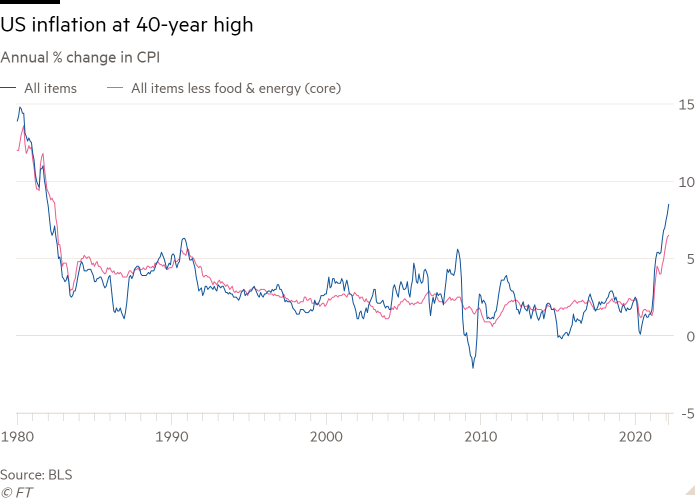[ad_1]
US consumer price growth surpassed 8 per cent in March, its fastest pace since 1981 following a surge in the cost of energy and food, maintaining pressure on the Federal Reserve to take aggressive action to tackle inflation.
The consumer price index increased 8.5 per cent last month compared with a year ago, marginally above Wall Street’s expectations, the Bureau of Labor Statistics said on Tuesday. The monthly rise was 1.2 per cent, the fastest jump since September 2005 and a sharp acceleration from the 0.8 per cent increase recorded in February.
Once volatile items such as food and energy are stripped out, “core” CPI advanced 0.3 per cent in March. That was the slowest rise since September, but still translated to a 6.5 per cent annual increase.
Lael Brainard, a Fed governor awaiting Senate confirmation to be the next vice-chair, warned of “upside” risks to inflation, citing Russia’s invasion of Ukraine — which is fuelling energy and food costs — and new Covid-19 lockdowns in China that could worsen supply chain constraints.
“The economy has sustained now a number of these kinds of inflationary shocks from external events,” she said at a Wall Street Journal event. “We’ve seen a lot of resilience but we’ve also seen very high inflation.”

It was the first inflation reading that included a full month of the impact of the war in Ukraine, which has significantly clouded the global outlook. Russia is one of the world’s largest energy exporters, and Russia and Ukraine are major suppliers of wheat and other grains.
The moderation in “core” CPI prompted a rally in Treasuries and overnight funding markets, as traders scaled back their bets for the pace and size of interest rate increases this year.
However, markets are still pricing a rise in the Fed’s benchmark policy rate to 2.42 per cent by the end of 2022, down from 2.59 per cent earlier in the day but sharply higher than the current range of 0.25 per cent to 0.50 per cent.
The Biden administration on Monday blamed surging prices on the war, with White House press secretary Jen Psaki saying the CPI reading would be “extraordinarily elevated due to Putin’s price hike”.
But Joe Manchin, the moderate Democratic senator from West Virginia, said on Tuesday: “The Federal Reserve and the administration failed to act fast enough, and today’s data is a snapshot in time of the consequences being felt across the country.”
He added that it was a “disservice to the American people to act as if inflation is a new phenomenon”.
Manchin, who has blocked Biden’s sweeping social spending plans on the grounds they were inflationary, said bringing prices “under control will require more aggressive action” from the Fed, as well as a shift in energy policy on Capitol Hill.
“Everyone is worried about inflation,” said Vincent Reinhart, a former senior Fed staff member who is now chief economist at Mellon. “It is number one in the polls. It is consuming the Fed’s bandwidth right now.”
The figures underscored the effect of volatile commodity prices, with a jump in petrol accounting for more than half of the overall increase in March CPI. Over the past year, prices at the pump have climbed 48 per cent, including an 18.3 per cent rise between March and February.
Beyond energy prices, core services prices accelerated in March, up 0.6 per cent from the previous month, or 4.7 per cent annually. That is the largest monthly jump since August 1992.
But there were signs that prices were slowing elsewhere. Used car prices, which have been skyrocketing since the coronavirus pandemic pushed many Americans away from mass transit, fell 3.8 per cent in March. The cost to buy a new vehicle rose 0.2 per cent from a month prior, a lower increase than the gain registered in February.
Concerns that inflation will become more deeply entrenched in the world’s largest economy have prompted the US central bank in recent weeks to assume a more aggressive approach to tightening monetary policy.
The Fed is now poised to raise interest rates by half a percentage point at its next policy meeting in May, double the pace of its March rate rise, as it seeks to lift its benchmark policy rate to a more “neutral” level that neither aids nor constrains growth by the end of the year.
Officials forecast that rate to be roughly 2.4 per cent, implying at least one more half-point adjustment in addition to four more quarter-point rate rises in 2022.
The central bank is also set to soon begin shrinking its $9tn balance sheet, building up to as much as $95bn a month over roughly three months.
Brainard said that process would start as early as June and, combined with rate rises, should bring the Fed’s policy to a more neutral setting “over time”.
US Treasury prices climbed on Tuesday, pushing the yield on the benchmark 10-year note down 0.06 percentage points to 2.72 per cent. Stocks, which had initially rallied after the data were released, slipped, with the S&P 500 falling 0.3 per cent in a volatile session.
[ad_2]
Source link

